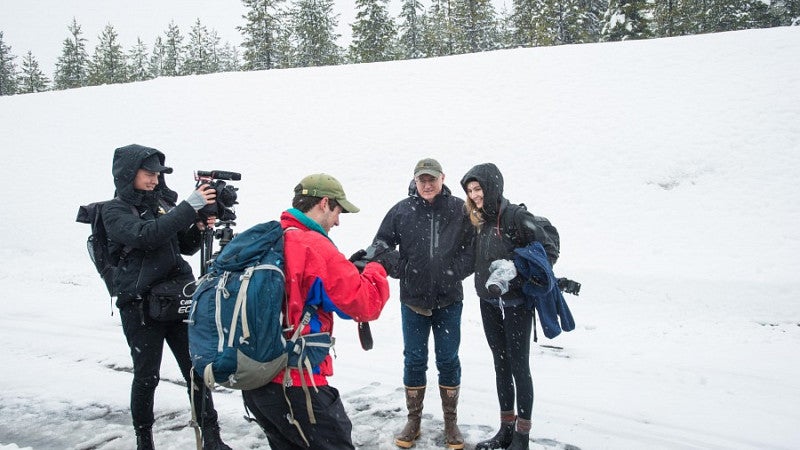Editor’s note: This student blog post is the first in a series of three written by UO students who attended a special field trip in April with Dennis Dimick, former picture and environment editor for National Geographic, founder of Eyes on Earth and the speaker for the SOJC’s 2018 combined Robert and Mabel Ruhl/Richard W. and Laurie Johnston lecture.
Story and photos by Brian Amdur
Two vans filled with UO students and various School of Journalism and Communication (SOJC) faculty pulled up to a slushy ski resort parking lot. It was an early-spring day this past winter term, and it was cold on the Santiam Pass.
Instead of skis slung on shoulders, we carried tripods and DSLR cameras to capture photos of what, at first, seemed like a cruddy wasteland of melted snow. Onlookers might wonder why a bunch of over-caffeinated students would bring all this fancy, expensive equipment to an empty ski resort.
As it turned out, it was the snow — or rather the lack of it — that brought us here.
I was one of the 18 journalism and environmental studies students who accompanied Dennis Dimick — National Geographic’s former picture and environment editor and this year’s SOJC Ruhl and Johnston lecturer — up the McKenzie River Watershed to the top of the pass. With an extensive background in working with photographers to visually capture stories of climate change, Dimick helped us strategize ways to share stories about the river in our own backyard.
As a photographer who focuses on environmental storytelling, I was beyond excited to have the opportunity to see how Dimick thinks about story development and talk to him about my own work.
At Santiam Pass, we talked about the changing climate and ecosystems in the Oregon Cascades, including the McKenzie River’s ever-decreasing snowpack. As our planet warms, the amount of snow that’s stored in the mountains melts sooner each summer. The earlier the snow melts, the quicker the ecosystem dries, creating greater fire danger. In 2015, Oregon spent a record $560 million on fire suppression. Perhaps more disturbing, the scars of recent wildfires and dead forests are becoming a common sight along the drive through the Cascades.
In addition to creating conditions conducive to more wildfire, a smaller snowpack also puts all the towns downstream of the McKenzie River at risk for drinking water shortages. And less water means the six dams on the river and its estuaries will generate less electricity by hydro power, forcing a greater reliance on fossil fuels to make up the difference.

Over time, we will see mid-elevation rain and snow transition zones — like Santiam Pass – slowly lose their ability to retain snow. While this will result in drought-like summers with little ground moisture, the winters will bring the opposite. Excessive rainfall — which in the past would have been snow — will lead to flooding. This new normal brings more of the extreme weather events we’re getting so used to hearing about.
As we stood around the parking lot attempting to grasp how our kids will likely never see this land covered in snow, the idea of creating a visually compelling story right now felt overwhelming.
A writer with 35 years of experience working on environmental stories, Dimick gave us a helpful tip for getting started. He said to read lots of scientific articles about the topic — in this case the Cascades’ declining snowpack. As journalists, translating complex scientific jargon into compelling narratives and crafting visual stories are our keys to fostering wider public understanding about confusing topics like snowpack. Dimick’s suggestion to use scientific databases as the building blocks to start an environmental story resonated with me, and I’ve been using that approach since the field trip.
As we moved downstream and into the lower-elevation forests, the group discussed the many directions we could take a story about the Cascades’ snowpack, from economics and recreation to ecosystem health and municipal water supply. I will be wildland firefighting this summer, so my plan is to capture images of the watershed’s fire-prone landscape and areas that have been in past fires. With Dimick’s help, I now feel better prepared to capture the images that can best tell that story.
Brian Amdur is an environmental studies major who enjoys creating photo stories about our changing climate. Originally from Evergreen, Colorado, Brian’s passion for playing outside is the foundation for his interest in nature photography. After graduating in June, he’ll be working as a wildland firefighter. You can see more of his work at BrianAmdur.com.

